Health Promotion: Chronic Disease Awareness in Rural Australia Project
VerifiedAdded on 2023/06/07
|12
|2988
|294
Report
AI Summary
This report details a health promotion initiative focused on raising awareness about chronic diseases in rural Australia, particularly within indigenous communities. It highlights the high prevalence of chronic diseases like cancer, cardiovascular disease, and diabetes, emphasizing the preventable nature of many through healthy lifestyles. The initiative aims to identify causes of high-risk factors, educate the community on healthy habits, and build local capacity for sustained health promotion. Strategies include surveys, community engagement through voluntary organizations, sensitization programs, and training for local groups. The implementation plan outlines stakeholder involvement, resource requirements, and communication strategies. An evaluation plan is also included to assess the project's progress and impact on community health, using surveys and data from health centers.
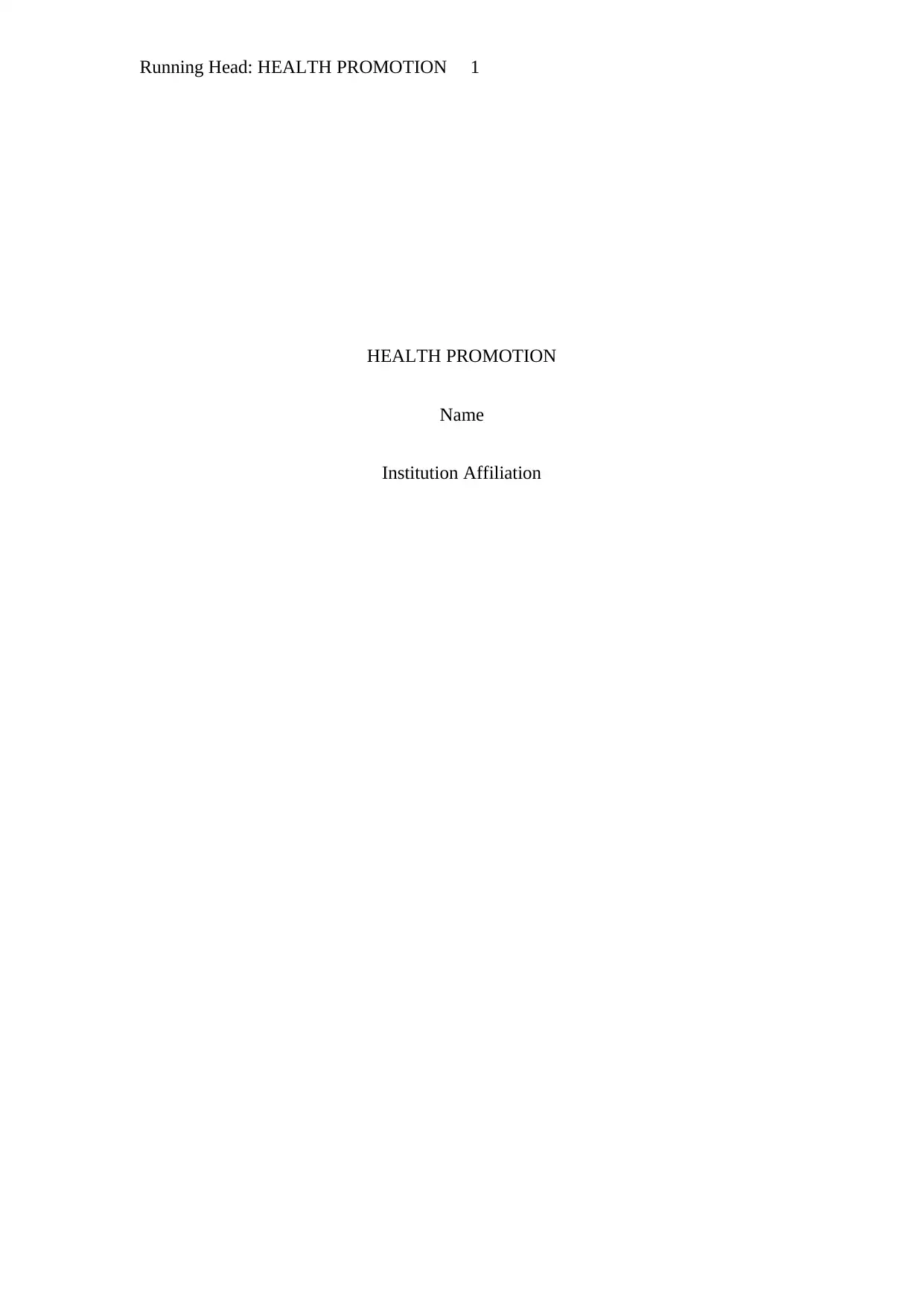
Running Head: HEALTH PROMOTION 1
HEALTH PROMOTION
Name
Institution Affiliation
HEALTH PROMOTION
Name
Institution Affiliation
Paraphrase This Document
Need a fresh take? Get an instant paraphrase of this document with our AI Paraphraser
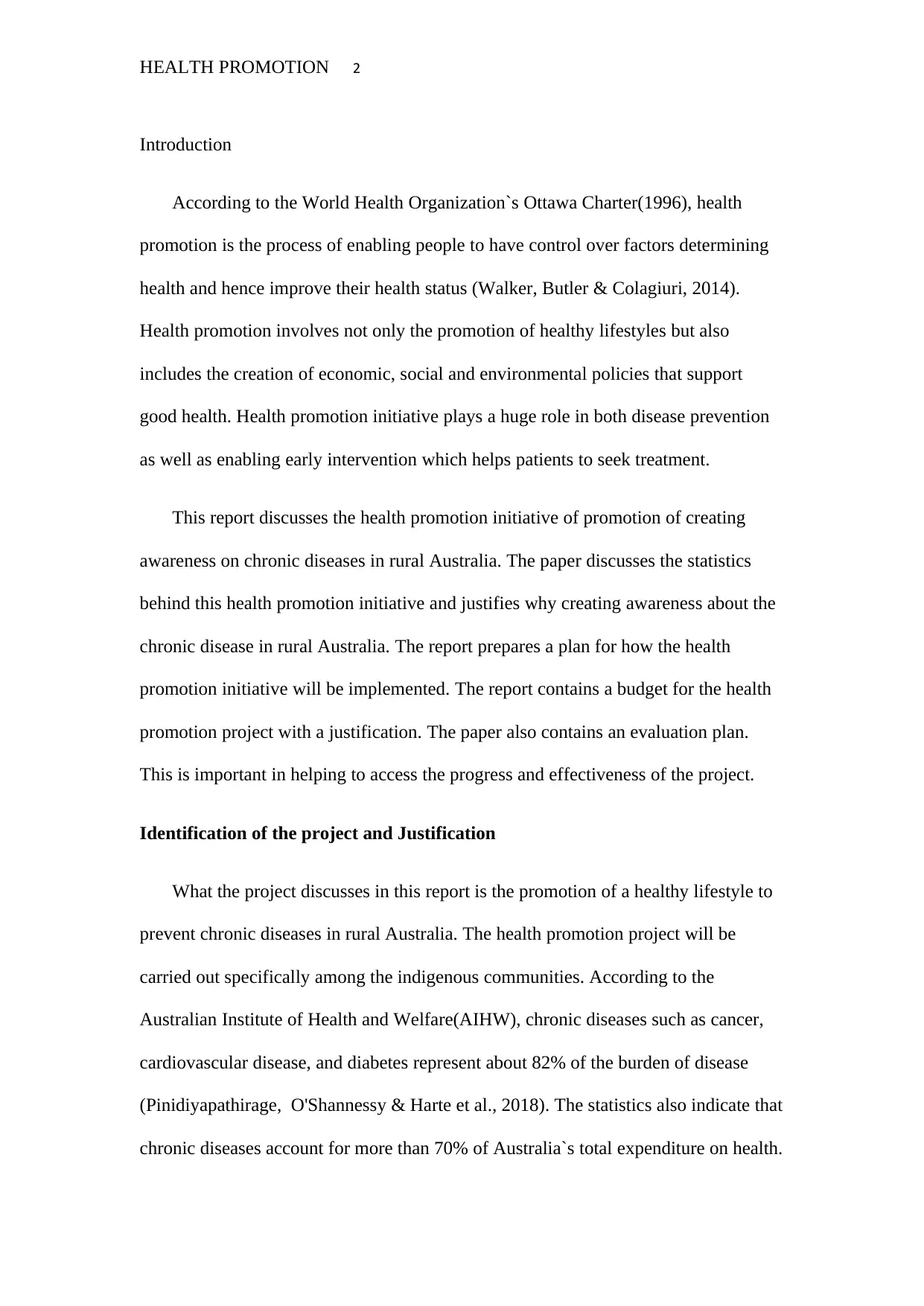
HEALTH PROMOTION 2
Introduction
According to the World Health Organization`s Ottawa Charter(1996), health
promotion is the process of enabling people to have control over factors determining
health and hence improve their health status (Walker, Butler & Colagiuri, 2014).
Health promotion involves not only the promotion of healthy lifestyles but also
includes the creation of economic, social and environmental policies that support
good health. Health promotion initiative plays a huge role in both disease prevention
as well as enabling early intervention which helps patients to seek treatment.
This report discusses the health promotion initiative of promotion of creating
awareness on chronic diseases in rural Australia. The paper discusses the statistics
behind this health promotion initiative and justifies why creating awareness about the
chronic disease in rural Australia. The report prepares a plan for how the health
promotion initiative will be implemented. The report contains a budget for the health
promotion project with a justification. The paper also contains an evaluation plan.
This is important in helping to access the progress and effectiveness of the project.
Identification of the project and Justification
What the project discusses in this report is the promotion of a healthy lifestyle to
prevent chronic diseases in rural Australia. The health promotion project will be
carried out specifically among the indigenous communities. According to the
Australian Institute of Health and Welfare(AIHW), chronic diseases such as cancer,
cardiovascular disease, and diabetes represent about 82% of the burden of disease
(Pinidiyapathirage, O'Shannessy & Harte et al., 2018). The statistics also indicate that
chronic diseases account for more than 70% of Australia`s total expenditure on health.
Introduction
According to the World Health Organization`s Ottawa Charter(1996), health
promotion is the process of enabling people to have control over factors determining
health and hence improve their health status (Walker, Butler & Colagiuri, 2014).
Health promotion involves not only the promotion of healthy lifestyles but also
includes the creation of economic, social and environmental policies that support
good health. Health promotion initiative plays a huge role in both disease prevention
as well as enabling early intervention which helps patients to seek treatment.
This report discusses the health promotion initiative of promotion of creating
awareness on chronic diseases in rural Australia. The paper discusses the statistics
behind this health promotion initiative and justifies why creating awareness about the
chronic disease in rural Australia. The report prepares a plan for how the health
promotion initiative will be implemented. The report contains a budget for the health
promotion project with a justification. The paper also contains an evaluation plan.
This is important in helping to access the progress and effectiveness of the project.
Identification of the project and Justification
What the project discusses in this report is the promotion of a healthy lifestyle to
prevent chronic diseases in rural Australia. The health promotion project will be
carried out specifically among the indigenous communities. According to the
Australian Institute of Health and Welfare(AIHW), chronic diseases such as cancer,
cardiovascular disease, and diabetes represent about 82% of the burden of disease
(Pinidiyapathirage, O'Shannessy & Harte et al., 2018). The statistics also indicate that
chronic diseases account for more than 70% of Australia`s total expenditure on health.
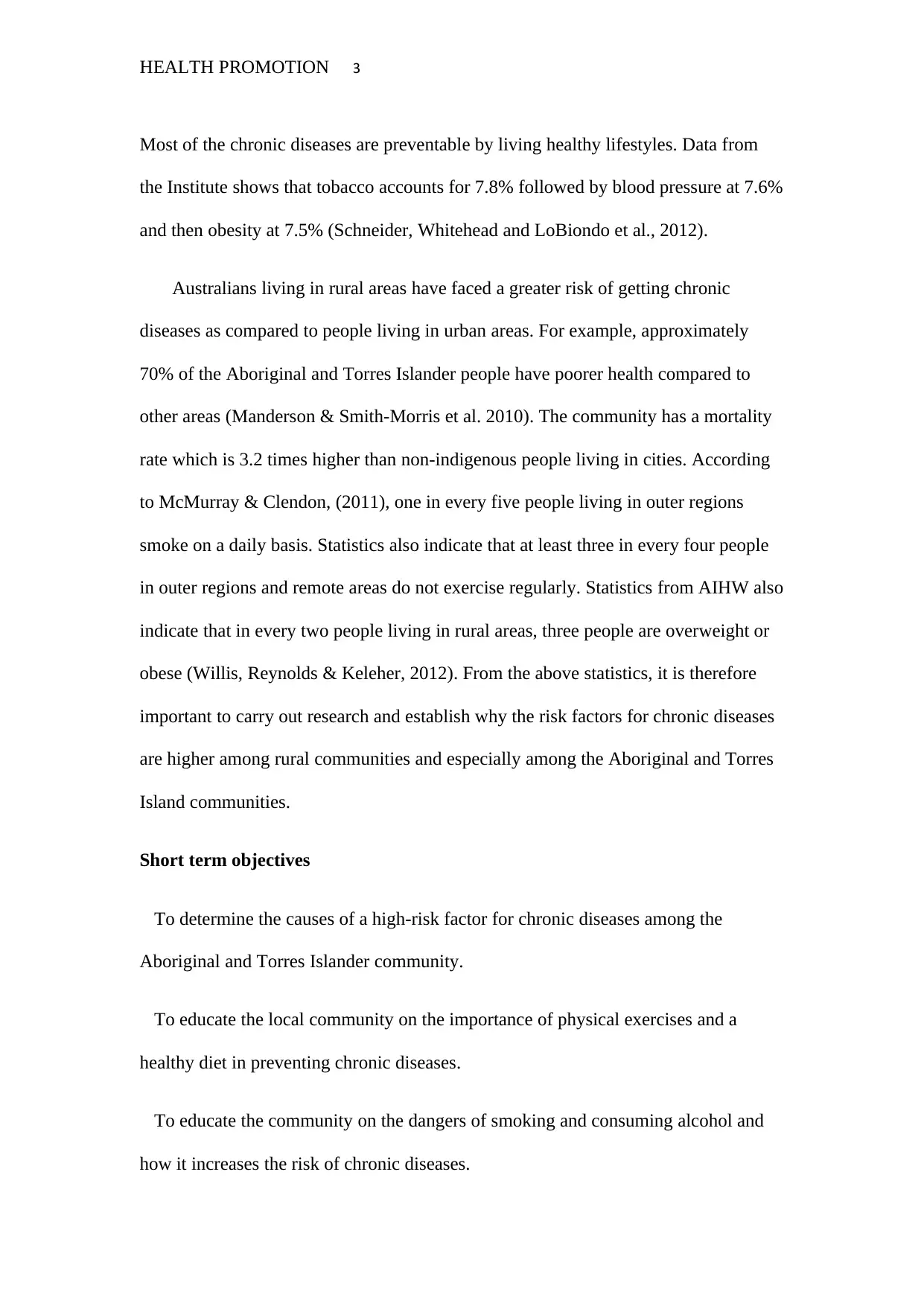
HEALTH PROMOTION 3
Most of the chronic diseases are preventable by living healthy lifestyles. Data from
the Institute shows that tobacco accounts for 7.8% followed by blood pressure at 7.6%
and then obesity at 7.5% (Schneider, Whitehead and LoBiondo et al., 2012).
Australians living in rural areas have faced a greater risk of getting chronic
diseases as compared to people living in urban areas. For example, approximately
70% of the Aboriginal and Torres Islander people have poorer health compared to
other areas (Manderson & Smith-Morris et al. 2010). The community has a mortality
rate which is 3.2 times higher than non-indigenous people living in cities. According
to McMurray & Clendon, (2011), one in every five people living in outer regions
smoke on a daily basis. Statistics also indicate that at least three in every four people
in outer regions and remote areas do not exercise regularly. Statistics from AIHW also
indicate that in every two people living in rural areas, three people are overweight or
obese (Willis, Reynolds & Keleher, 2012). From the above statistics, it is therefore
important to carry out research and establish why the risk factors for chronic diseases
are higher among rural communities and especially among the Aboriginal and Torres
Island communities.
Short term objectives
To determine the causes of a high-risk factor for chronic diseases among the
Aboriginal and Torres Islander community.
To educate the local community on the importance of physical exercises and a
healthy diet in preventing chronic diseases.
To educate the community on the dangers of smoking and consuming alcohol and
how it increases the risk of chronic diseases.
Most of the chronic diseases are preventable by living healthy lifestyles. Data from
the Institute shows that tobacco accounts for 7.8% followed by blood pressure at 7.6%
and then obesity at 7.5% (Schneider, Whitehead and LoBiondo et al., 2012).
Australians living in rural areas have faced a greater risk of getting chronic
diseases as compared to people living in urban areas. For example, approximately
70% of the Aboriginal and Torres Islander people have poorer health compared to
other areas (Manderson & Smith-Morris et al. 2010). The community has a mortality
rate which is 3.2 times higher than non-indigenous people living in cities. According
to McMurray & Clendon, (2011), one in every five people living in outer regions
smoke on a daily basis. Statistics also indicate that at least three in every four people
in outer regions and remote areas do not exercise regularly. Statistics from AIHW also
indicate that in every two people living in rural areas, three people are overweight or
obese (Willis, Reynolds & Keleher, 2012). From the above statistics, it is therefore
important to carry out research and establish why the risk factors for chronic diseases
are higher among rural communities and especially among the Aboriginal and Torres
Island communities.
Short term objectives
To determine the causes of a high-risk factor for chronic diseases among the
Aboriginal and Torres Islander community.
To educate the local community on the importance of physical exercises and a
healthy diet in preventing chronic diseases.
To educate the community on the dangers of smoking and consuming alcohol and
how it increases the risk of chronic diseases.
⊘ This is a preview!⊘
Do you want full access?
Subscribe today to unlock all pages.

Trusted by 1+ million students worldwide
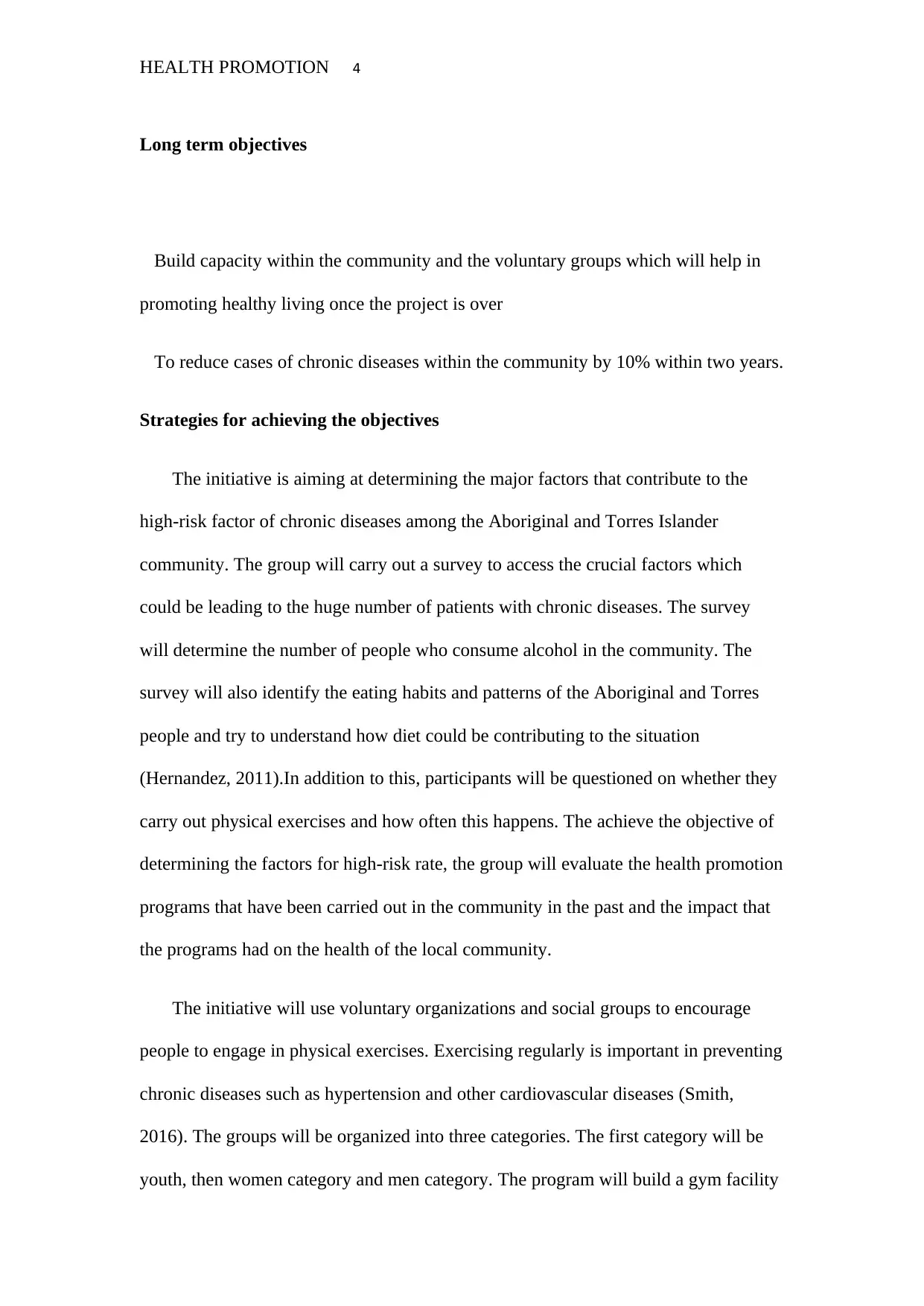
HEALTH PROMOTION 4
Long term objectives
Build capacity within the community and the voluntary groups which will help in
promoting healthy living once the project is over
To reduce cases of chronic diseases within the community by 10% within two years.
Strategies for achieving the objectives
The initiative is aiming at determining the major factors that contribute to the
high-risk factor of chronic diseases among the Aboriginal and Torres Islander
community. The group will carry out a survey to access the crucial factors which
could be leading to the huge number of patients with chronic diseases. The survey
will determine the number of people who consume alcohol in the community. The
survey will also identify the eating habits and patterns of the Aboriginal and Torres
people and try to understand how diet could be contributing to the situation
(Hernandez, 2011).In addition to this, participants will be questioned on whether they
carry out physical exercises and how often this happens. The achieve the objective of
determining the factors for high-risk rate, the group will evaluate the health promotion
programs that have been carried out in the community in the past and the impact that
the programs had on the health of the local community.
The initiative will use voluntary organizations and social groups to encourage
people to engage in physical exercises. Exercising regularly is important in preventing
chronic diseases such as hypertension and other cardiovascular diseases (Smith,
2016). The groups will be organized into three categories. The first category will be
youth, then women category and men category. The program will build a gym facility
Long term objectives
Build capacity within the community and the voluntary groups which will help in
promoting healthy living once the project is over
To reduce cases of chronic diseases within the community by 10% within two years.
Strategies for achieving the objectives
The initiative is aiming at determining the major factors that contribute to the
high-risk factor of chronic diseases among the Aboriginal and Torres Islander
community. The group will carry out a survey to access the crucial factors which
could be leading to the huge number of patients with chronic diseases. The survey
will determine the number of people who consume alcohol in the community. The
survey will also identify the eating habits and patterns of the Aboriginal and Torres
people and try to understand how diet could be contributing to the situation
(Hernandez, 2011).In addition to this, participants will be questioned on whether they
carry out physical exercises and how often this happens. The achieve the objective of
determining the factors for high-risk rate, the group will evaluate the health promotion
programs that have been carried out in the community in the past and the impact that
the programs had on the health of the local community.
The initiative will use voluntary organizations and social groups to encourage
people to engage in physical exercises. Exercising regularly is important in preventing
chronic diseases such as hypertension and other cardiovascular diseases (Smith,
2016). The groups will be organized into three categories. The first category will be
youth, then women category and men category. The program will build a gym facility
Paraphrase This Document
Need a fresh take? Get an instant paraphrase of this document with our AI Paraphraser
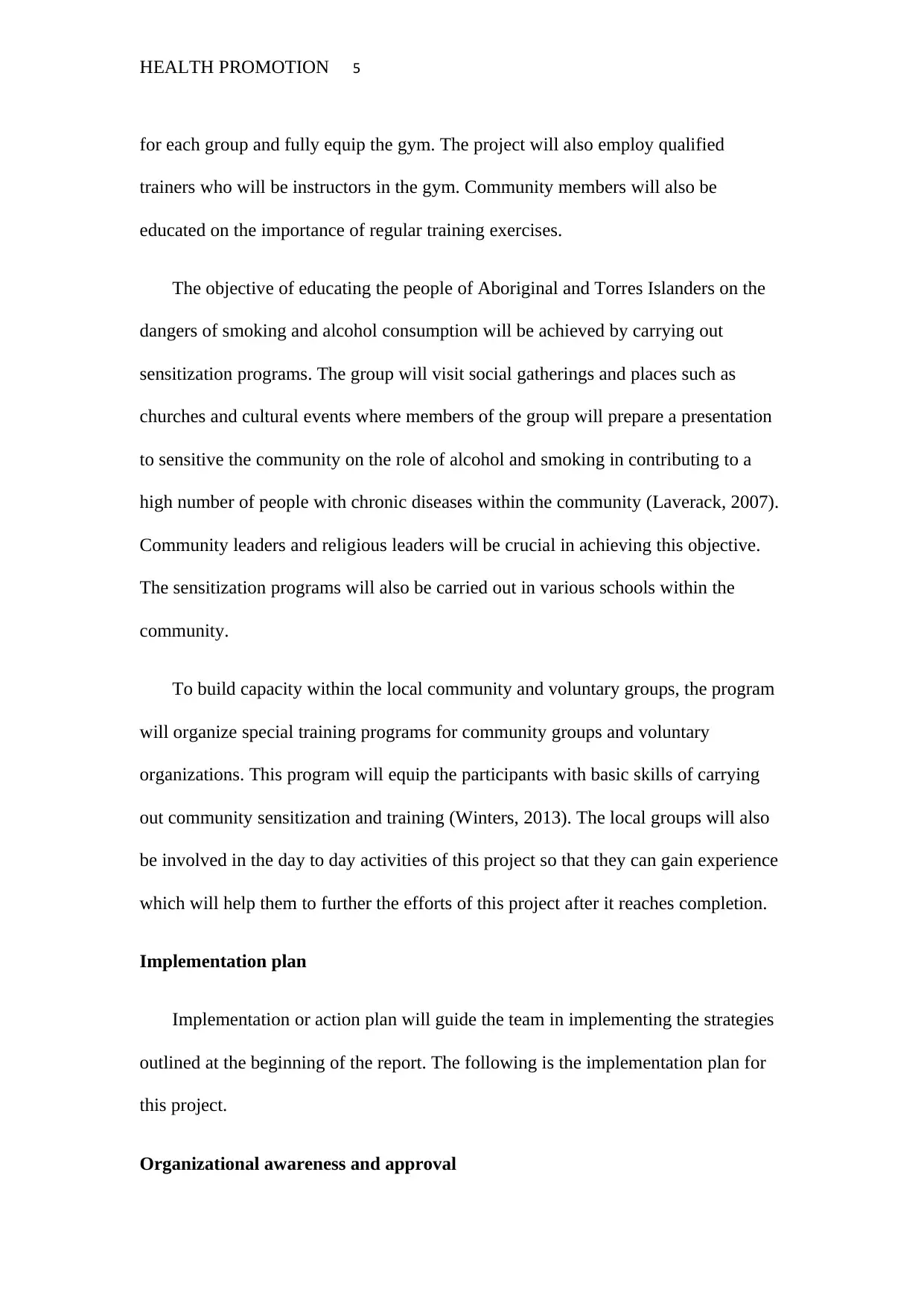
HEALTH PROMOTION 5
for each group and fully equip the gym. The project will also employ qualified
trainers who will be instructors in the gym. Community members will also be
educated on the importance of regular training exercises.
The objective of educating the people of Aboriginal and Torres Islanders on the
dangers of smoking and alcohol consumption will be achieved by carrying out
sensitization programs. The group will visit social gatherings and places such as
churches and cultural events where members of the group will prepare a presentation
to sensitive the community on the role of alcohol and smoking in contributing to a
high number of people with chronic diseases within the community (Laverack, 2007).
Community leaders and religious leaders will be crucial in achieving this objective.
The sensitization programs will also be carried out in various schools within the
community.
To build capacity within the local community and voluntary groups, the program
will organize special training programs for community groups and voluntary
organizations. This program will equip the participants with basic skills of carrying
out community sensitization and training (Winters, 2013). The local groups will also
be involved in the day to day activities of this project so that they can gain experience
which will help them to further the efforts of this project after it reaches completion.
Implementation plan
Implementation or action plan will guide the team in implementing the strategies
outlined at the beginning of the report. The following is the implementation plan for
this project.
Organizational awareness and approval
for each group and fully equip the gym. The project will also employ qualified
trainers who will be instructors in the gym. Community members will also be
educated on the importance of regular training exercises.
The objective of educating the people of Aboriginal and Torres Islanders on the
dangers of smoking and alcohol consumption will be achieved by carrying out
sensitization programs. The group will visit social gatherings and places such as
churches and cultural events where members of the group will prepare a presentation
to sensitive the community on the role of alcohol and smoking in contributing to a
high number of people with chronic diseases within the community (Laverack, 2007).
Community leaders and religious leaders will be crucial in achieving this objective.
The sensitization programs will also be carried out in various schools within the
community.
To build capacity within the local community and voluntary groups, the program
will organize special training programs for community groups and voluntary
organizations. This program will equip the participants with basic skills of carrying
out community sensitization and training (Winters, 2013). The local groups will also
be involved in the day to day activities of this project so that they can gain experience
which will help them to further the efforts of this project after it reaches completion.
Implementation plan
Implementation or action plan will guide the team in implementing the strategies
outlined at the beginning of the report. The following is the implementation plan for
this project.
Organizational awareness and approval
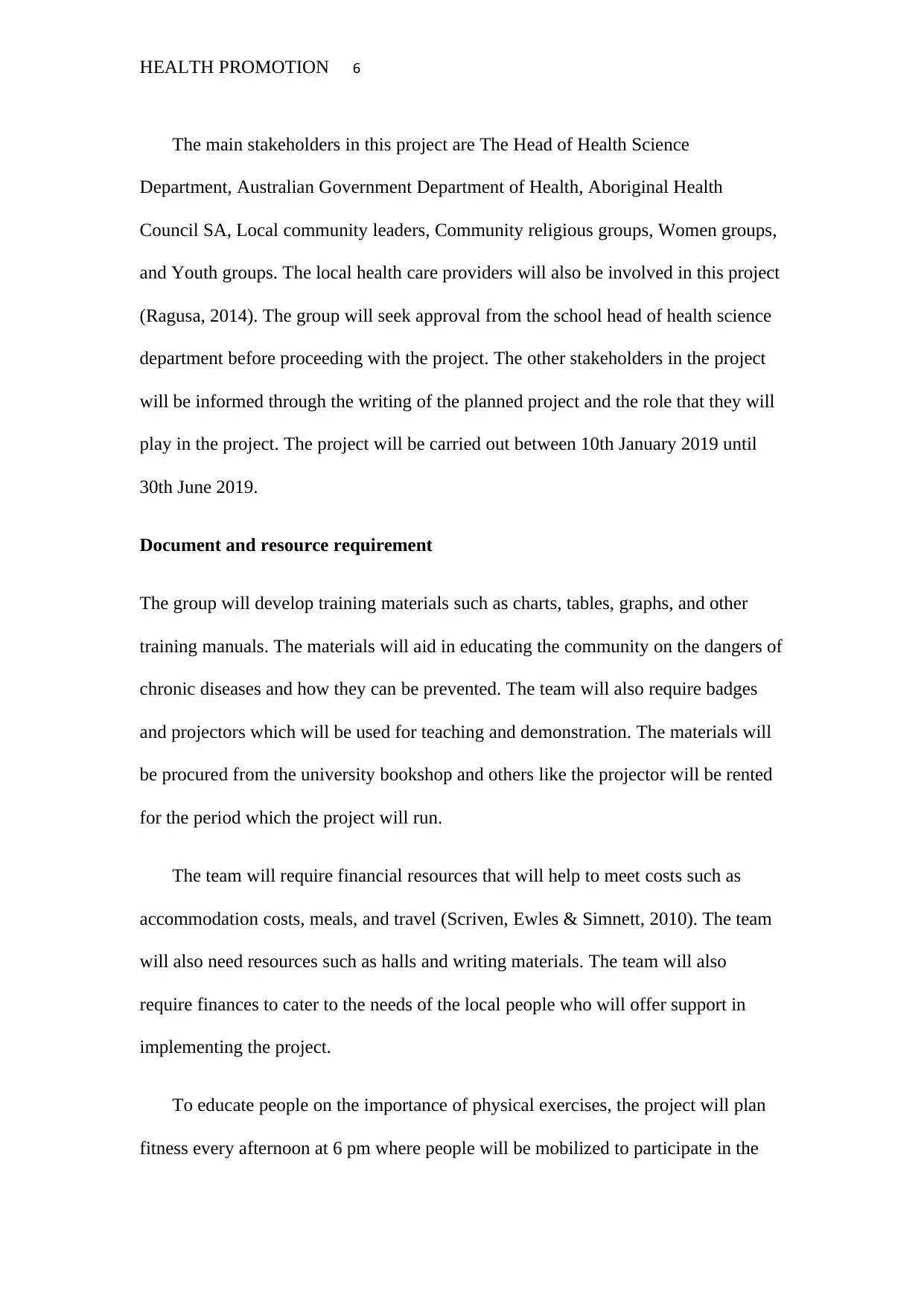
HEALTH PROMOTION 6
The main stakeholders in this project are The Head of Health Science
Department, Australian Government Department of Health, Aboriginal Health
Council SA, Local community leaders, Community religious groups, Women groups,
and Youth groups. The local health care providers will also be involved in this project
(Ragusa, 2014). The group will seek approval from the school head of health science
department before proceeding with the project. The other stakeholders in the project
will be informed through the writing of the planned project and the role that they will
play in the project. The project will be carried out between 10th January 2019 until
30th June 2019.
Document and resource requirement
The group will develop training materials such as charts, tables, graphs, and other
training manuals. The materials will aid in educating the community on the dangers of
chronic diseases and how they can be prevented. The team will also require badges
and projectors which will be used for teaching and demonstration. The materials will
be procured from the university bookshop and others like the projector will be rented
for the period which the project will run.
The team will require financial resources that will help to meet costs such as
accommodation costs, meals, and travel (Scriven, Ewles & Simnett, 2010). The team
will also need resources such as halls and writing materials. The team will also
require finances to cater to the needs of the local people who will offer support in
implementing the project.
To educate people on the importance of physical exercises, the project will plan
fitness every afternoon at 6 pm where people will be mobilized to participate in the
The main stakeholders in this project are The Head of Health Science
Department, Australian Government Department of Health, Aboriginal Health
Council SA, Local community leaders, Community religious groups, Women groups,
and Youth groups. The local health care providers will also be involved in this project
(Ragusa, 2014). The group will seek approval from the school head of health science
department before proceeding with the project. The other stakeholders in the project
will be informed through the writing of the planned project and the role that they will
play in the project. The project will be carried out between 10th January 2019 until
30th June 2019.
Document and resource requirement
The group will develop training materials such as charts, tables, graphs, and other
training manuals. The materials will aid in educating the community on the dangers of
chronic diseases and how they can be prevented. The team will also require badges
and projectors which will be used for teaching and demonstration. The materials will
be procured from the university bookshop and others like the projector will be rented
for the period which the project will run.
The team will require financial resources that will help to meet costs such as
accommodation costs, meals, and travel (Scriven, Ewles & Simnett, 2010). The team
will also need resources such as halls and writing materials. The team will also
require finances to cater to the needs of the local people who will offer support in
implementing the project.
To educate people on the importance of physical exercises, the project will plan
fitness every afternoon at 6 pm where people will be mobilized to participate in the
⊘ This is a preview!⊘
Do you want full access?
Subscribe today to unlock all pages.

Trusted by 1+ million students worldwide

HEALTH PROMOTION 7
fitness exercise. The project will also encourage students and young people to engage
in sports at school in order to remain healthy (Nolte, Knai & McKee, 2008). After two
months, the project will build and equip gyms for the groups involved in this project.
This will be of great importance to the community even after the project comes to an
end. Furthermore, the objective of changing the eating habits of the people will be
important will helping to prevent chronic diseases among the Aboriginal & Torres
Islanders. Various groups will be educated on the importance of diet in promoting a
healthy lifestyle. The people will be encouraged to consume traditional non-processed
foods which have fewer calories. The project will also target schools to promote
proper diet among students in schools. The program will engage the school
management to find ways in which healthy eating can be promoted in schools.
Schools will be urged to provide foods with as little sugar as possible to ensure that
school going kids grow when they are very healthy.
Communication plan
The project will communicate to government departments through writing. The
group will write weakly reports to the department to communicate on the progress of
the project. The group will also communicate with the financiers of the project on a
weekly basis and whenever necessary. He project will also communicate through
emails and phone conversations. For this project, it will also be crucial to have
nonformal means of communication such as social media campaigns (Clavier & De,
2013). The project will also distribute posters for training. The
Education and training
fitness exercise. The project will also encourage students and young people to engage
in sports at school in order to remain healthy (Nolte, Knai & McKee, 2008). After two
months, the project will build and equip gyms for the groups involved in this project.
This will be of great importance to the community even after the project comes to an
end. Furthermore, the objective of changing the eating habits of the people will be
important will helping to prevent chronic diseases among the Aboriginal & Torres
Islanders. Various groups will be educated on the importance of diet in promoting a
healthy lifestyle. The people will be encouraged to consume traditional non-processed
foods which have fewer calories. The project will also target schools to promote
proper diet among students in schools. The program will engage the school
management to find ways in which healthy eating can be promoted in schools.
Schools will be urged to provide foods with as little sugar as possible to ensure that
school going kids grow when they are very healthy.
Communication plan
The project will communicate to government departments through writing. The
group will write weakly reports to the department to communicate on the progress of
the project. The group will also communicate with the financiers of the project on a
weekly basis and whenever necessary. He project will also communicate through
emails and phone conversations. For this project, it will also be crucial to have
nonformal means of communication such as social media campaigns (Clavier & De,
2013). The project will also distribute posters for training. The
Education and training
Paraphrase This Document
Need a fresh take? Get an instant paraphrase of this document with our AI Paraphraser
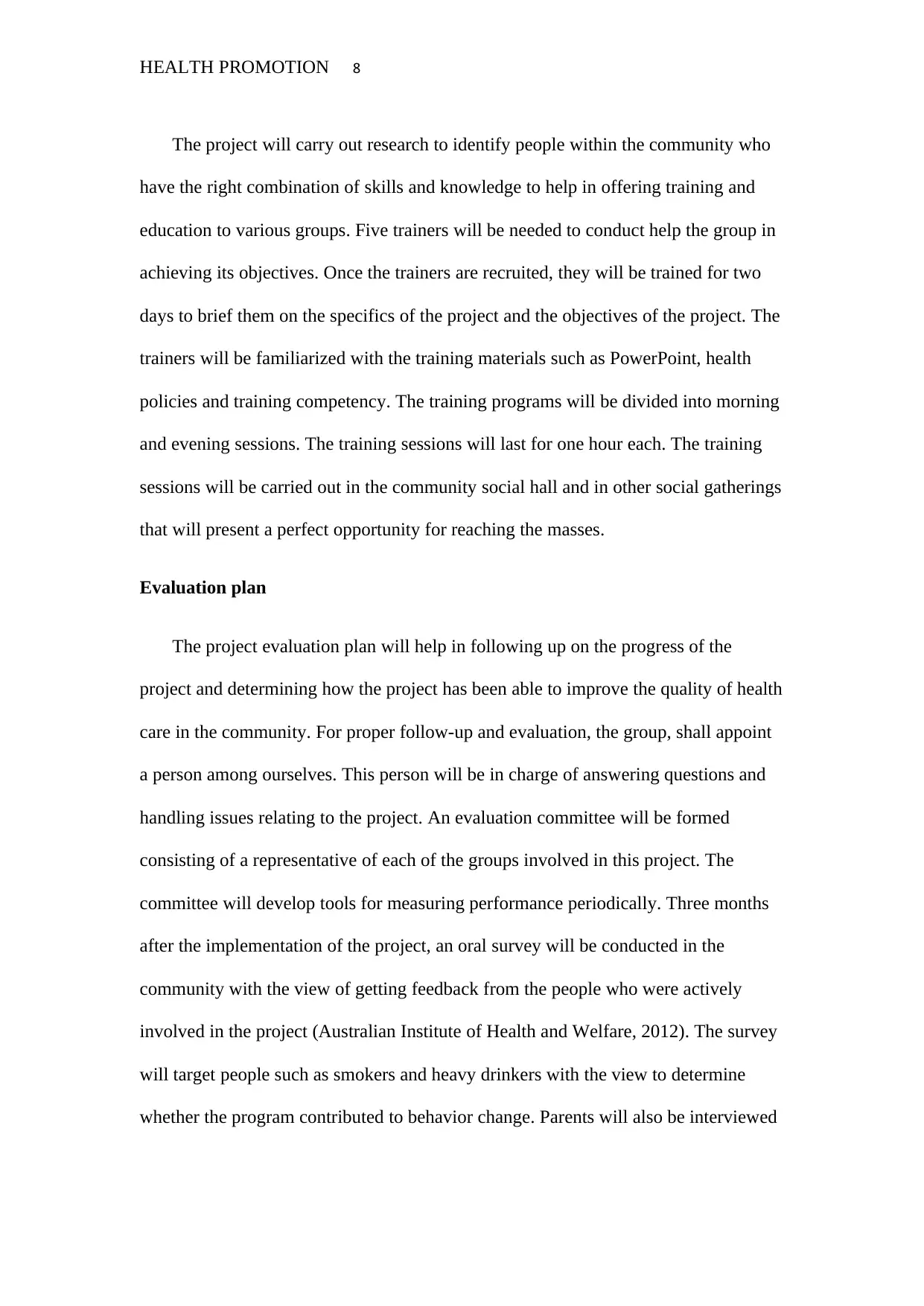
HEALTH PROMOTION 8
The project will carry out research to identify people within the community who
have the right combination of skills and knowledge to help in offering training and
education to various groups. Five trainers will be needed to conduct help the group in
achieving its objectives. Once the trainers are recruited, they will be trained for two
days to brief them on the specifics of the project and the objectives of the project. The
trainers will be familiarized with the training materials such as PowerPoint, health
policies and training competency. The training programs will be divided into morning
and evening sessions. The training sessions will last for one hour each. The training
sessions will be carried out in the community social hall and in other social gatherings
that will present a perfect opportunity for reaching the masses.
Evaluation plan
The project evaluation plan will help in following up on the progress of the
project and determining how the project has been able to improve the quality of health
care in the community. For proper follow-up and evaluation, the group, shall appoint
a person among ourselves. This person will be in charge of answering questions and
handling issues relating to the project. An evaluation committee will be formed
consisting of a representative of each of the groups involved in this project. The
committee will develop tools for measuring performance periodically. Three months
after the implementation of the project, an oral survey will be conducted in the
community with the view of getting feedback from the people who were actively
involved in the project (Australian Institute of Health and Welfare, 2012). The survey
will target people such as smokers and heavy drinkers with the view to determine
whether the program contributed to behavior change. Parents will also be interviewed
The project will carry out research to identify people within the community who
have the right combination of skills and knowledge to help in offering training and
education to various groups. Five trainers will be needed to conduct help the group in
achieving its objectives. Once the trainers are recruited, they will be trained for two
days to brief them on the specifics of the project and the objectives of the project. The
trainers will be familiarized with the training materials such as PowerPoint, health
policies and training competency. The training programs will be divided into morning
and evening sessions. The training sessions will last for one hour each. The training
sessions will be carried out in the community social hall and in other social gatherings
that will present a perfect opportunity for reaching the masses.
Evaluation plan
The project evaluation plan will help in following up on the progress of the
project and determining how the project has been able to improve the quality of health
care in the community. For proper follow-up and evaluation, the group, shall appoint
a person among ourselves. This person will be in charge of answering questions and
handling issues relating to the project. An evaluation committee will be formed
consisting of a representative of each of the groups involved in this project. The
committee will develop tools for measuring performance periodically. Three months
after the implementation of the project, an oral survey will be conducted in the
community with the view of getting feedback from the people who were actively
involved in the project (Australian Institute of Health and Welfare, 2012). The survey
will target people such as smokers and heavy drinkers with the view to determine
whether the program contributed to behavior change. Parents will also be interviewed
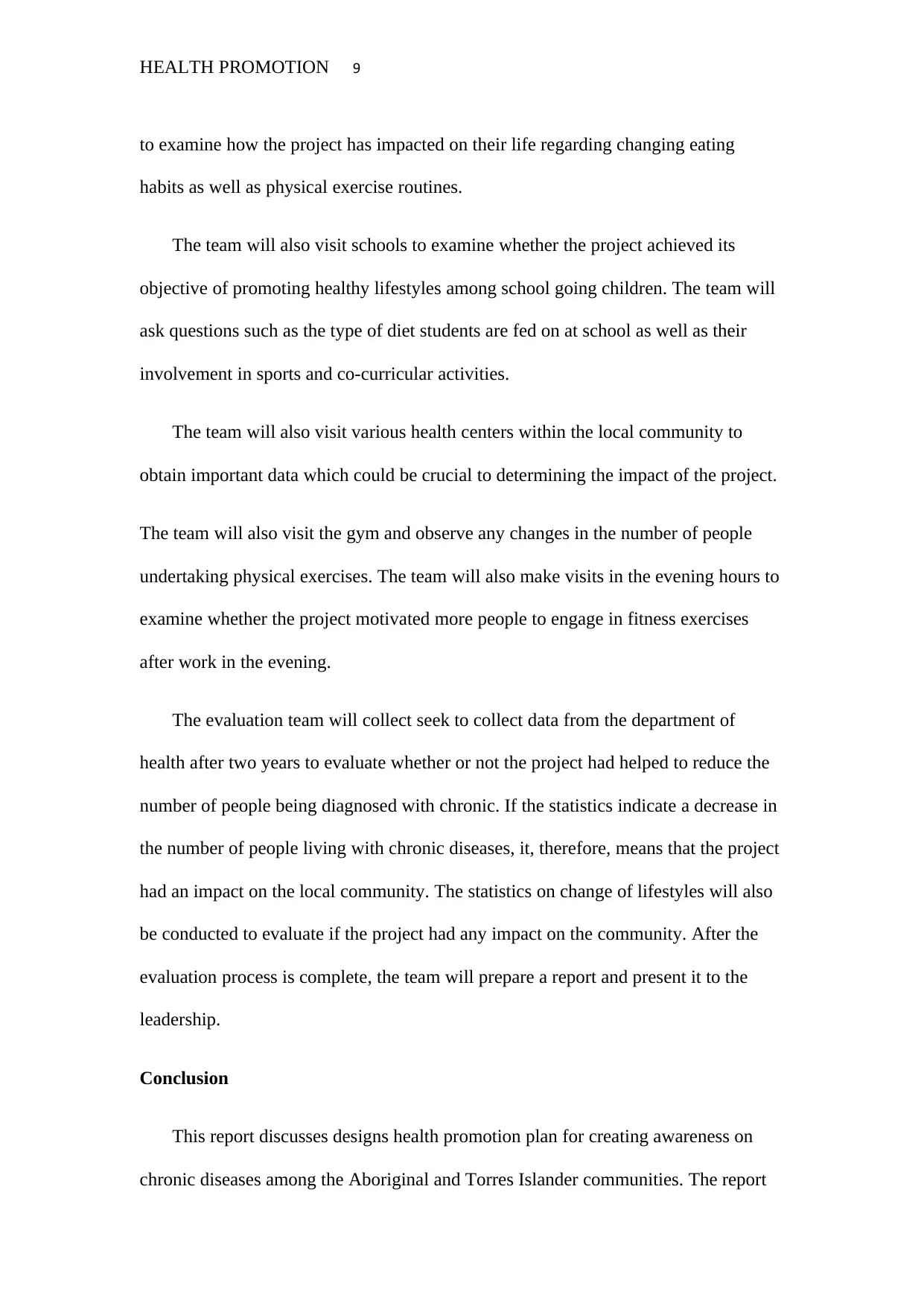
HEALTH PROMOTION 9
to examine how the project has impacted on their life regarding changing eating
habits as well as physical exercise routines.
The team will also visit schools to examine whether the project achieved its
objective of promoting healthy lifestyles among school going children. The team will
ask questions such as the type of diet students are fed on at school as well as their
involvement in sports and co-curricular activities.
The team will also visit various health centers within the local community to
obtain important data which could be crucial to determining the impact of the project.
The team will also visit the gym and observe any changes in the number of people
undertaking physical exercises. The team will also make visits in the evening hours to
examine whether the project motivated more people to engage in fitness exercises
after work in the evening.
The evaluation team will collect seek to collect data from the department of
health after two years to evaluate whether or not the project had helped to reduce the
number of people being diagnosed with chronic. If the statistics indicate a decrease in
the number of people living with chronic diseases, it, therefore, means that the project
had an impact on the local community. The statistics on change of lifestyles will also
be conducted to evaluate if the project had any impact on the community. After the
evaluation process is complete, the team will prepare a report and present it to the
leadership.
Conclusion
This report discusses designs health promotion plan for creating awareness on
chronic diseases among the Aboriginal and Torres Islander communities. The report
to examine how the project has impacted on their life regarding changing eating
habits as well as physical exercise routines.
The team will also visit schools to examine whether the project achieved its
objective of promoting healthy lifestyles among school going children. The team will
ask questions such as the type of diet students are fed on at school as well as their
involvement in sports and co-curricular activities.
The team will also visit various health centers within the local community to
obtain important data which could be crucial to determining the impact of the project.
The team will also visit the gym and observe any changes in the number of people
undertaking physical exercises. The team will also make visits in the evening hours to
examine whether the project motivated more people to engage in fitness exercises
after work in the evening.
The evaluation team will collect seek to collect data from the department of
health after two years to evaluate whether or not the project had helped to reduce the
number of people being diagnosed with chronic. If the statistics indicate a decrease in
the number of people living with chronic diseases, it, therefore, means that the project
had an impact on the local community. The statistics on change of lifestyles will also
be conducted to evaluate if the project had any impact on the community. After the
evaluation process is complete, the team will prepare a report and present it to the
leadership.
Conclusion
This report discusses designs health promotion plan for creating awareness on
chronic diseases among the Aboriginal and Torres Islander communities. The report
⊘ This is a preview!⊘
Do you want full access?
Subscribe today to unlock all pages.

Trusted by 1+ million students worldwide
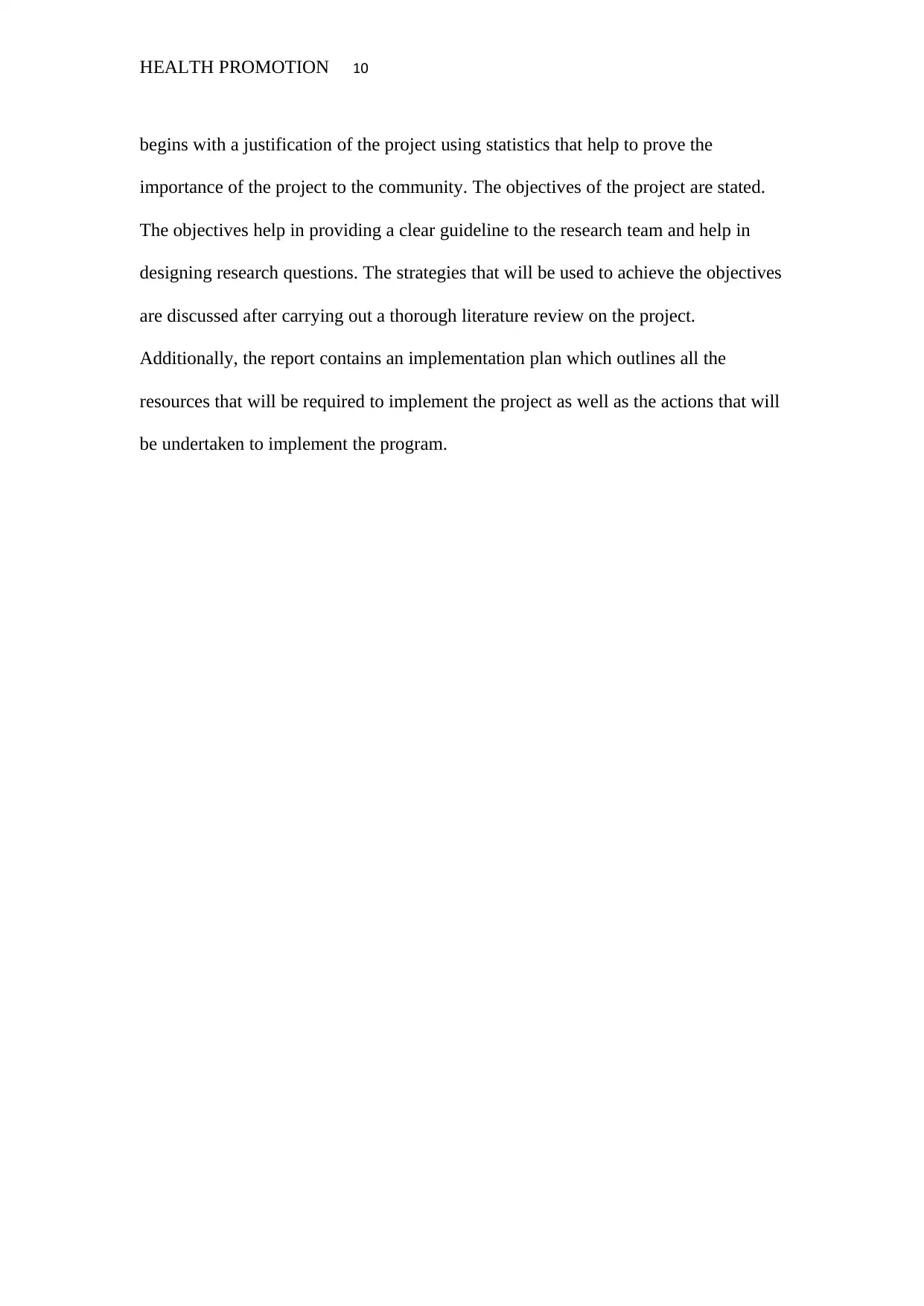
HEALTH PROMOTION 10
begins with a justification of the project using statistics that help to prove the
importance of the project to the community. The objectives of the project are stated.
The objectives help in providing a clear guideline to the research team and help in
designing research questions. The strategies that will be used to achieve the objectives
are discussed after carrying out a thorough literature review on the project.
Additionally, the report contains an implementation plan which outlines all the
resources that will be required to implement the project as well as the actions that will
be undertaken to implement the program.
begins with a justification of the project using statistics that help to prove the
importance of the project to the community. The objectives of the project are stated.
The objectives help in providing a clear guideline to the research team and help in
designing research questions. The strategies that will be used to achieve the objectives
are discussed after carrying out a thorough literature review on the project.
Additionally, the report contains an implementation plan which outlines all the
resources that will be required to implement the project as well as the actions that will
be undertaken to implement the program.
Paraphrase This Document
Need a fresh take? Get an instant paraphrase of this document with our AI Paraphraser
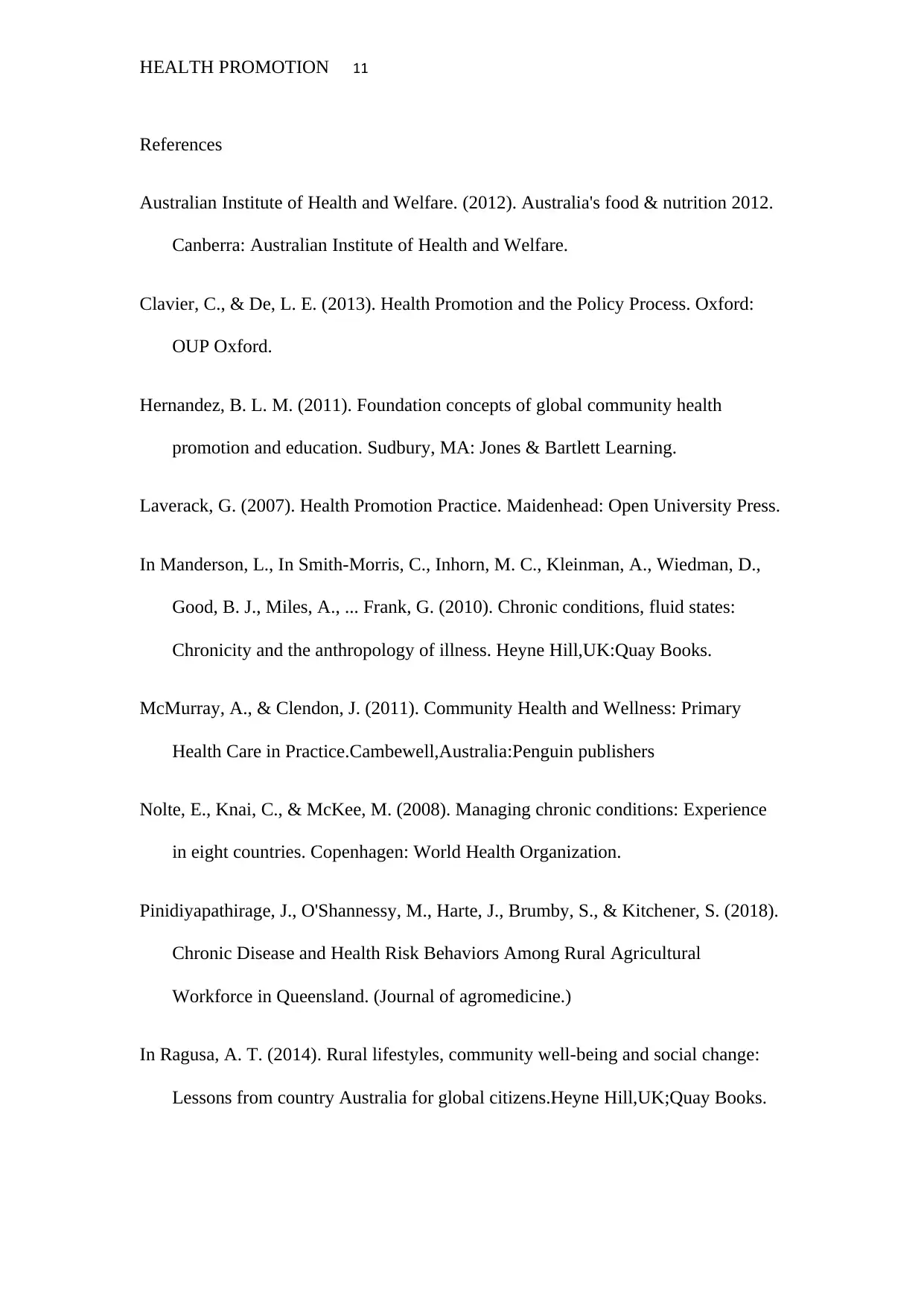
HEALTH PROMOTION 11
References
Australian Institute of Health and Welfare. (2012). Australia's food & nutrition 2012.
Canberra: Australian Institute of Health and Welfare.
Clavier, C., & De, L. E. (2013). Health Promotion and the Policy Process. Oxford:
OUP Oxford.
Hernandez, B. L. M. (2011). Foundation concepts of global community health
promotion and education. Sudbury, MA: Jones & Bartlett Learning.
Laverack, G. (2007). Health Promotion Practice. Maidenhead: Open University Press.
In Manderson, L., In Smith-Morris, C., Inhorn, M. C., Kleinman, A., Wiedman, D.,
Good, B. J., Miles, A., ... Frank, G. (2010). Chronic conditions, fluid states:
Chronicity and the anthropology of illness. Heyne Hill,UK:Quay Books.
McMurray, A., & Clendon, J. (2011). Community Health and Wellness: Primary
Health Care in Practice.Cambewell,Australia:Penguin publishers
Nolte, E., Knai, C., & McKee, M. (2008). Managing chronic conditions: Experience
in eight countries. Copenhagen: World Health Organization.
Pinidiyapathirage, J., O'Shannessy, M., Harte, J., Brumby, S., & Kitchener, S. (2018).
Chronic Disease and Health Risk Behaviors Among Rural Agricultural
Workforce in Queensland. (Journal of agromedicine.)
In Ragusa, A. T. (2014). Rural lifestyles, community well-being and social change:
Lessons from country Australia for global citizens.Heyne Hill,UK;Quay Books.
References
Australian Institute of Health and Welfare. (2012). Australia's food & nutrition 2012.
Canberra: Australian Institute of Health and Welfare.
Clavier, C., & De, L. E. (2013). Health Promotion and the Policy Process. Oxford:
OUP Oxford.
Hernandez, B. L. M. (2011). Foundation concepts of global community health
promotion and education. Sudbury, MA: Jones & Bartlett Learning.
Laverack, G. (2007). Health Promotion Practice. Maidenhead: Open University Press.
In Manderson, L., In Smith-Morris, C., Inhorn, M. C., Kleinman, A., Wiedman, D.,
Good, B. J., Miles, A., ... Frank, G. (2010). Chronic conditions, fluid states:
Chronicity and the anthropology of illness. Heyne Hill,UK:Quay Books.
McMurray, A., & Clendon, J. (2011). Community Health and Wellness: Primary
Health Care in Practice.Cambewell,Australia:Penguin publishers
Nolte, E., Knai, C., & McKee, M. (2008). Managing chronic conditions: Experience
in eight countries. Copenhagen: World Health Organization.
Pinidiyapathirage, J., O'Shannessy, M., Harte, J., Brumby, S., & Kitchener, S. (2018).
Chronic Disease and Health Risk Behaviors Among Rural Agricultural
Workforce in Queensland. (Journal of agromedicine.)
In Ragusa, A. T. (2014). Rural lifestyles, community well-being and social change:
Lessons from country Australia for global citizens.Heyne Hill,UK;Quay Books.
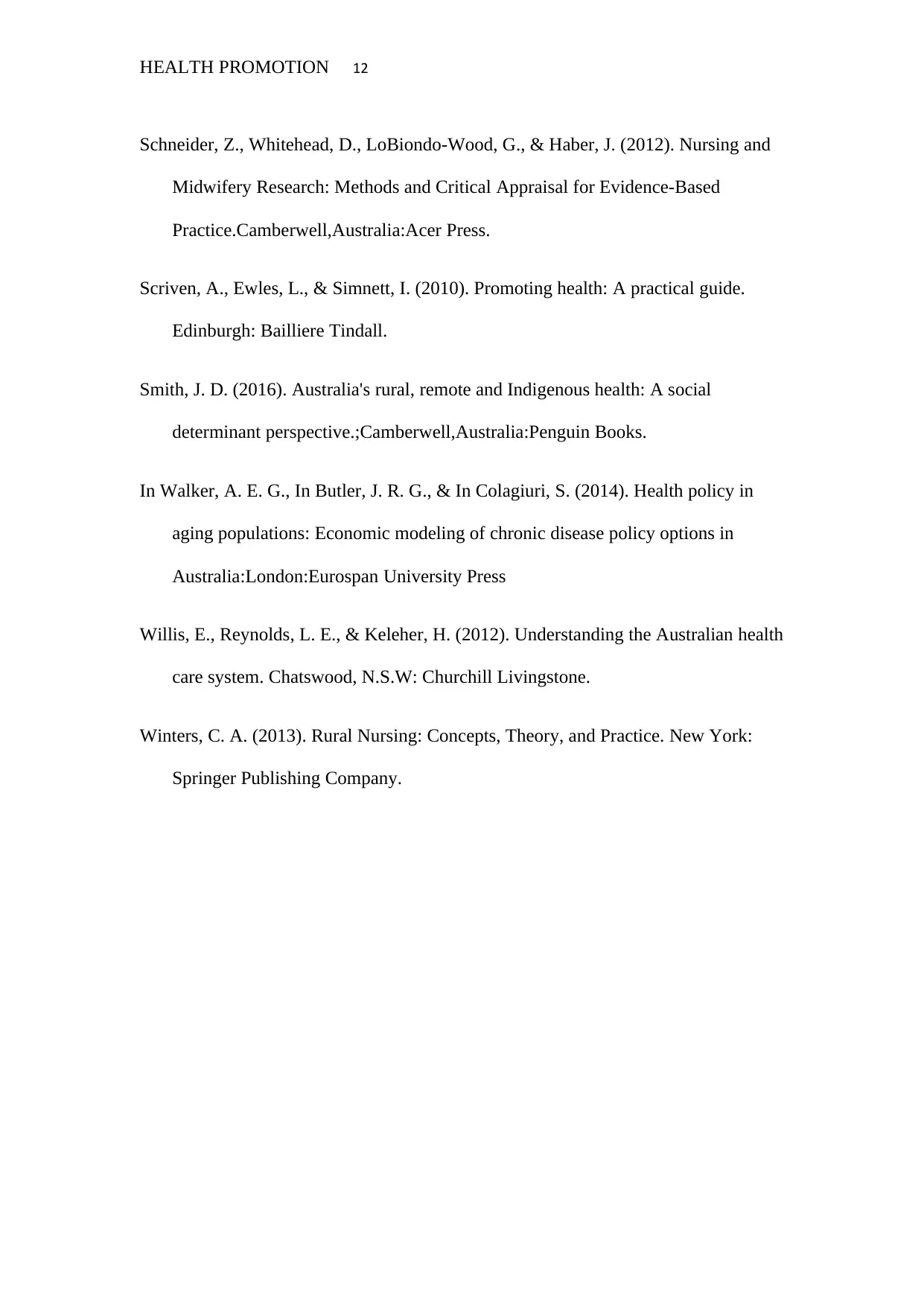
HEALTH PROMOTION 12
Schneider, Z., Whitehead, D., LoBiondo-Wood, G., & Haber, J. (2012). Nursing and
Midwifery Research: Methods and Critical Appraisal for Evidence-Based
Practice.Camberwell,Australia:Acer Press.
Scriven, A., Ewles, L., & Simnett, I. (2010). Promoting health: A practical guide.
Edinburgh: Bailliere Tindall.
Smith, J. D. (2016). Australia's rural, remote and Indigenous health: A social
determinant perspective.;Camberwell,Australia:Penguin Books.
In Walker, A. E. G., In Butler, J. R. G., & In Colagiuri, S. (2014). Health policy in
aging populations: Economic modeling of chronic disease policy options in
Australia:London:Eurospan University Press
Willis, E., Reynolds, L. E., & Keleher, H. (2012). Understanding the Australian health
care system. Chatswood, N.S.W: Churchill Livingstone.
Winters, C. A. (2013). Rural Nursing: Concepts, Theory, and Practice. New York:
Springer Publishing Company.
Schneider, Z., Whitehead, D., LoBiondo-Wood, G., & Haber, J. (2012). Nursing and
Midwifery Research: Methods and Critical Appraisal for Evidence-Based
Practice.Camberwell,Australia:Acer Press.
Scriven, A., Ewles, L., & Simnett, I. (2010). Promoting health: A practical guide.
Edinburgh: Bailliere Tindall.
Smith, J. D. (2016). Australia's rural, remote and Indigenous health: A social
determinant perspective.;Camberwell,Australia:Penguin Books.
In Walker, A. E. G., In Butler, J. R. G., & In Colagiuri, S. (2014). Health policy in
aging populations: Economic modeling of chronic disease policy options in
Australia:London:Eurospan University Press
Willis, E., Reynolds, L. E., & Keleher, H. (2012). Understanding the Australian health
care system. Chatswood, N.S.W: Churchill Livingstone.
Winters, C. A. (2013). Rural Nursing: Concepts, Theory, and Practice. New York:
Springer Publishing Company.
⊘ This is a preview!⊘
Do you want full access?
Subscribe today to unlock all pages.

Trusted by 1+ million students worldwide
1 out of 12
Related Documents
Your All-in-One AI-Powered Toolkit for Academic Success.
+13062052269
info@desklib.com
Available 24*7 on WhatsApp / Email
![[object Object]](/_next/static/media/star-bottom.7253800d.svg)
Unlock your academic potential
Copyright © 2020–2025 A2Z Services. All Rights Reserved. Developed and managed by ZUCOL.





